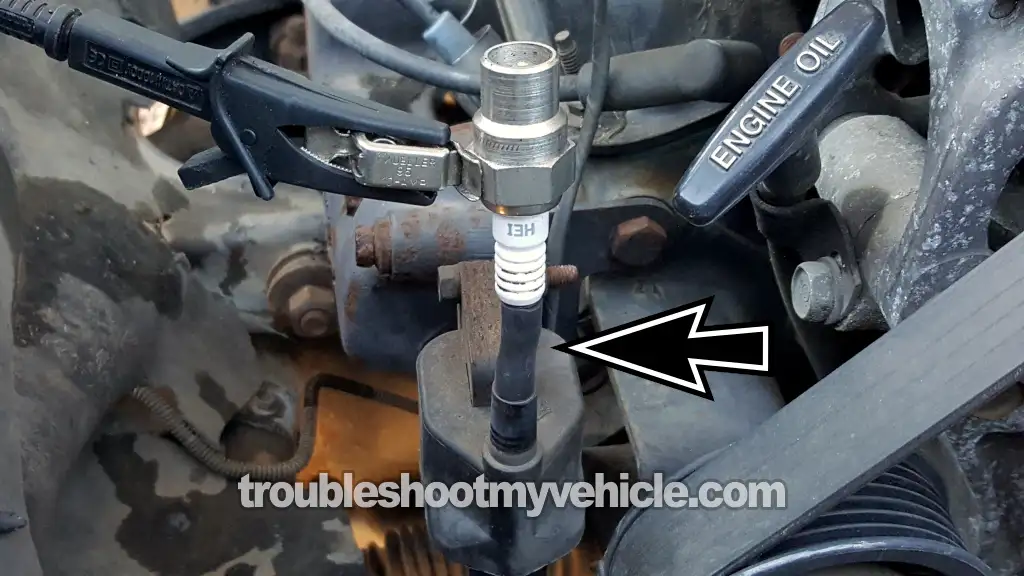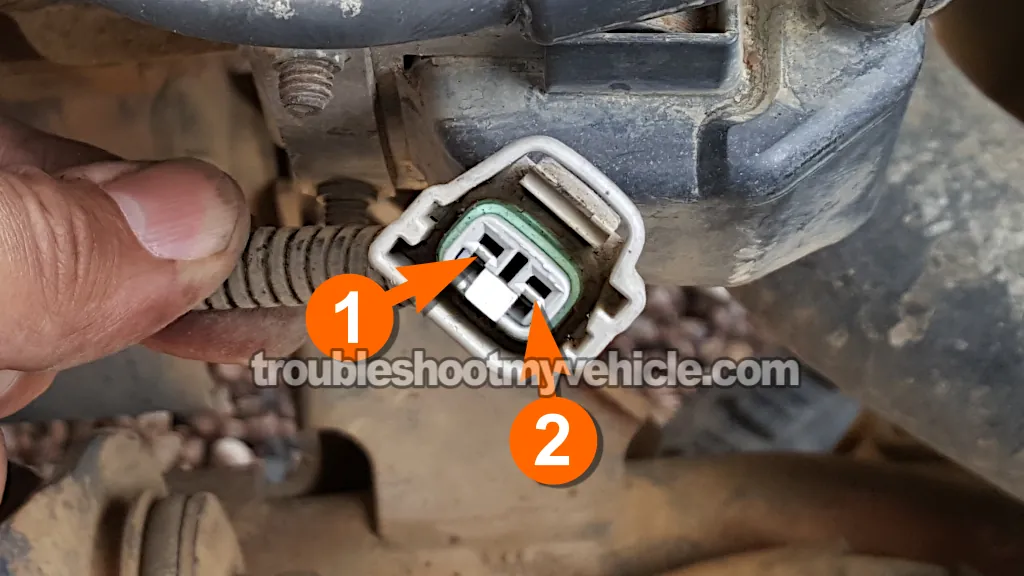TEST 3: Testing The Ignition Coil's High Tension Wire For Spark

If you've made it this far, it means that in TEST 1, none of the eight spark plug wires fired off any spark.
Now we're gonna check if the ignition coil's high-tension wire is sending spark when you crank the engine.
If you see the spark tester lighting up, that tells you the ignition coil's doing its job —the real problem is with the distributor cap or rotor. That's what's stopping your Dodge Ram pickup's engine from starting (and why there's no spark at the plug wires).
If the tester stays dark (no spark), your next step is TEST 4, where you'll check for spark right at the ignition coil's tower.
Here's how to run this test:
- 1
Disconnect the high-tension wire from the center of the distributor cap.
NOTE: Make sure the other end of the wire stays plugged into the ignition coil. - 2
Connect your spark tester to the end of that wire —the end you just pulled off the distributor cap (check the photo above if you need a quick look).
NOTE: The other end of this high tension wire must stay connected to the ignition coil. - 3
Ground the spark tester by clipping it to the battery's negative (-) terminal with a jumper cable.
- 4
Have your helper crank the engine while you hold the spark tester and watch for it to spark.
- 5
The spark tester should be firing spark the whole time the engine's cranking.
Let's figure out what it all means:
CASE 1: The spark tester fires spark. That's exactly what you want to see.
This confirms the engine no-start issue is with the distributor cap or rotor —but only if both of these are true:
- Back in TEST 1, you saw that none of the spark plug wires were firing spark.
- And just now, you confirmed the ignition coil wire is sending spark.
To get your V8 Dodge Ram pickup starting again, swap out the spark plug wires with a brand-new set.
It's not required, but if your spark plugs, cap, and rotor are just as old as the wires, it's a smart move to replace them too.
CASE 2: No spark from the tester. That means the distributor's not getting spark.
Your next move is to test for spark directly on the ignition coil's tower. Jump over to: TEST 4: Testing The Ignition Coil For Spark.
TEST 4: Testing The Ignition Coil For Spark

So far, TEST 1 and TEST 3 have confirmed a few things for us:
- TEST 1: None of the eight spark plug wires are delivering spark.
- TEST 3: The ignition coil's high-tension wire isn't sparking either.
Now it's time to check for spark right at the ignition coil's tower —just like you see in the photo above.
If you get spark coming out of the coil's tower, the ignition coil itself is good. That means the high-tension wire is the real troublemaker —it's not carrying the spark over to the distributor cap (and yeah, this kind of failure's pretty common). That's why there's no spark and no-start.
If you still don't see spark at the ignition coil's tower, then it's time to roll into the next step: TEST 5.
Let's get going:
- 1
Disconnect the high-tension wire from the ignition coil.
- 2
Using a small piece of vacuum hose, connect your spark tester to the ignition coil's tower (check the photo above for reference).
NOTE: The arrow in the photo points to the vacuum hose I'm using to secure the spark tester to the ignition coil's tower. - 3
Ground the spark tester by connecting it to the battery's negative (-) terminal using a jumper cable.
- 4
Have your helper crank the engine while you keep your eyes on the spark tester.
- 5
You should see a steady spark inside the tester the whole time the engine's cranking.
Now, let's break down what your results mean:
CASE 1: You got a steady spark. That's exactly what you want.
This tells you the ignition coil itself is working just fine. If you've already confirmed:
- No spark from any of the spark plug wires in TEST 1,
- No spark from the ignition coil's high-tension wire in TEST 3,
- And now, spark straight from the coil in this test,
Then the problem's crystal clear —the high-tension wire from the coil is shot. Replace it, and while you're at it, swap in a full new set of spark plug wires to get your engine firing again.
CASE 2: No spark from the tester. Alright, your next move is to find out if the ignition coil's even getting power.
Let's head over to: TEST 5: Making Sure The Ignition Coil Is Getting 12 Volts.
TEST 5: Making Sure The Ignition Coil Is Getting 12 Volts
Now we're gonna make sure the ignition coil's actually getting power —specifically 10 to 12 Volts. Without that voltage (which comes from the Auto Shutdown Relay, or ASD relay), the coil won't throw any spark at all.
The wire delivering that voltage is the dark green with orange stripe (DK GRN/ORG) of the ignition coil's 2-wire connector, regardless of the style of connector.
In the photo above, I've labeled the terminal that connects to the DK GRN/ORG wire with the number 1.
We'll use a multimeter to check for voltage at that wire while the engine's cranking —and that's super important. You won't get a real reading unless the engine's turning over.
CAUTION: Since this test needs the engine to crank, stay sharp and follow all safety steps while you're working around moving parts!
Alright, here's how to get started:
- 1
Disconnect the ignition coil from its 2-wire connector.
- 2
Connect the black test lead to the battery's negative (-) post.
- 3
Set your multimeter to DC Volts mode.
- 4
Touch the red test lead to connector terminal 1.
NOTE: Double-check that the terminal actually corresponds to the DK GRN/ORG wire. - 5
Have your helper crank the engine while you keep an eye on the multimeter screen.
- 6
You should see 10 to 12 Volts showing on the display.
Now, here's what your results mean:
CASE 1: You see 10 to 12 Volts. That's exactly what you wanna see —it means the ignition coil's getting the power it needs.
Since you're chasing a no-spark, no-start issue, the next thing to check is if the ignition coil is being sent with an activation signal. Jump over to: TEST 6: Testing The Ignition Coil's Activation Signal.
CASE 2: No voltage at the terminal. That's a clear sign the ignition coil isn't getting any power —so it can't fire off any spark.
Most of the time, that comes down to one of two things:
- A break in the wire running between the ignition coil connector and the ASD (Auto Shutdown) relay.
- Either the CMP sensor or CKP sensor is bad (if the PCM doesn't see any of these signals, it doesn't enable the ASD relay and power doesn't reach the ignition coil).
CMP SENSOR TESTS:
- How To Test The Camshaft Position Sensor (1992-1995 5.2L, 5.9L V8 Dodge Ram Pickup).
- How To Test The Camshaft Position Sensor (1996-1997 5.2L, 5.9L V8 Dodge Ram Pickup).
- How To Test The Camshaft Position Sensor (1998-2003 5.2L, 5.9L V8 Dodge Ram Pickup).
CKP SENSOR TESTS:


